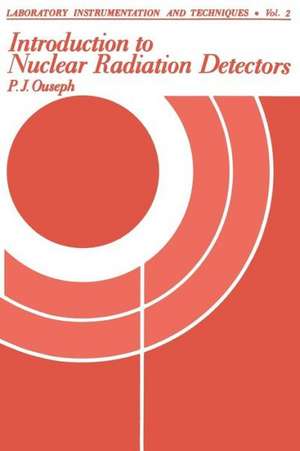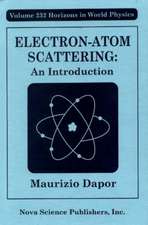Introduction to Nuclear Radiation Detectors: Laboratory Instrumentation and Techniques, cartea 2
Autor P. Ousephen Limba Engleză Paperback – 16 feb 2012
Preț: 382.57 lei
Nou
Puncte Express: 574
Preț estimativ în valută:
73.21€ • 78.28$ • 61.04£
73.21€ • 78.28$ • 61.04£
Carte tipărită la comandă
Livrare economică 18 aprilie-02 mai
Preluare comenzi: 021 569.72.76
Specificații
ISBN-13: 9781468408379
ISBN-10: 1468408372
Pagini: 208
Ilustrații: XII, 194 p.
Dimensiuni: 152 x 229 x 11 mm
Greutate: 0.29 kg
Ediția:Softcover reprint of the original 1st ed. 1975
Editura: Springer Us
Colecția Springer
Seria Laboratory Instrumentation and Techniques
Locul publicării:New York, NY, United States
ISBN-10: 1468408372
Pagini: 208
Ilustrații: XII, 194 p.
Dimensiuni: 152 x 229 x 11 mm
Greutate: 0.29 kg
Ediția:Softcover reprint of the original 1st ed. 1975
Editura: Springer Us
Colecția Springer
Seria Laboratory Instrumentation and Techniques
Locul publicării:New York, NY, United States
Public țintă
ResearchCuprins
1 Introduction.- 2 Nuclear Radiations and Their Interaction with Matter.- 2.1. Radioactivity.- 2.2. Radioactivity Calculations.- 2.3. Calculation of Activities Produced by Nuclear Reactions.- 2.4. Interaction of Heavy Charged Particles with Matter.- 2.5. Electron Interaction.- 2.6. Backscattering of Electrons.- 2.7. Interaction of Gamma and X Rays with Matter.- 2.8. Interaction of Neutrons.- 2.9. Cosmic Rays.- References.- 3 Gas Counters.- 3.1. General Properties of Gas Counters.- 3.2. Ionization Counters.- 3.3. Air-Wall Ionization Chamber.- 3.4. Pocket Dosimeter.- 3.5. Pulse-Type Ionization Counter.- 3.6. Proportional Counter.- 3.7. Position-Sensitive Proportional Counters.- 3.8. Neutron Counters.- 3.9. Geiger-Müller Counters.- 3.10. Counter Gas.- 3.11. Detection of Alpha and Beta Radiations by Geiger Counters.- 3.12. Detection of X Rays and Gamma Rays by Gas Counters.- 3.13. Application of Internal Counting Methods.- References.- 4 Scintillation Counters.- 4.1. General Characteristics of Scintillation Counting Systems.- 4.2. Scintillant Materials and Mechanism of Scintillation.- 4.3. Photomultipliers.- 4.4. The Shape of the Pulse.- 4.5. Scintillation Counter Assembly.- 4.6. Relationship between Pulse Height and Energy.- 4.7. Detection of Gamma Rays by Scintillation Counters.- 4.8. Integral Counting.- 4.9. Differential Counting and Determination of Energy of Gamma Rays.- 4.10. Efficiency of Scintillation Counters for Gamma Detection.- 4.11. Energy Resolution in Scintillant Detectors.- 4.12. Detection of Charged Particles with Scintillation Counters.- 4.13. Detection of Neutrons.- 4.14. Particle Identification by Pulse Shape Discrimination.- 4.15. Other Methods for Particle Identification and Discrimination.- References.- 5 Semiconductor Detectors.- 5.1. Operation of aSemiconductor Counter.- 5.2. Impurity Semiconductors.- 5.3. Detector Types.- 5.4. Pulse Shape and Rise Time.- 5.5. Factors Affecting Energy Resolution.- 5.6. Radiation Damage.- 5.7. Detection of Charged Particles.- 5.8. X-Ray and Gamma-Ray Detection.- 5.9. Neutron Detectors.- 5.10. Other Applications.- 5.11. Special Techniques.- 5.12. Concluding Remarks.- References.- Bibliography,.- 6 Corrections in Radiation Counting.- 6.1. Introduction.- 6.2. Absolute Activity Determination.- 6.3. Random Nature of Decay Process.- 6.4. Frequency Distributions.- 6.5. Statistical Errors in Nuclear Particle Counting.- References.- Appendix: Selected Constants and Conversion Factors.















